Holmes Institute: Business and Corporate Law Case Study Report
VerifiedAdded on 2022/11/14
|11
|2372
|370
Report
AI Summary
This report presents a comprehensive analysis of two case studies in Business and Corporate Law. Part A examines a contract law issue, focusing on offer, acceptance, and revocation in the context of a promotional offer by SOO Burger. It applies relevant case law, including Carlill v Carbolic Smoke Ball Company and Payne v Cave, to determine SOO Burger's liability to provide cars to Mickey and Brett. Part B delves into corporate law, assessing the breach of directors' duties by Mercedes and Gregg. It explores the duties of care, diligence, good faith, and the implications of insolvent trading under the Corporations Act 2001, referencing key cases like ASIC v Flugge and Tourprint v Bott. The report provides detailed legal arguments, applications of relevant legislation, and conclusions on the liabilities of the involved parties.
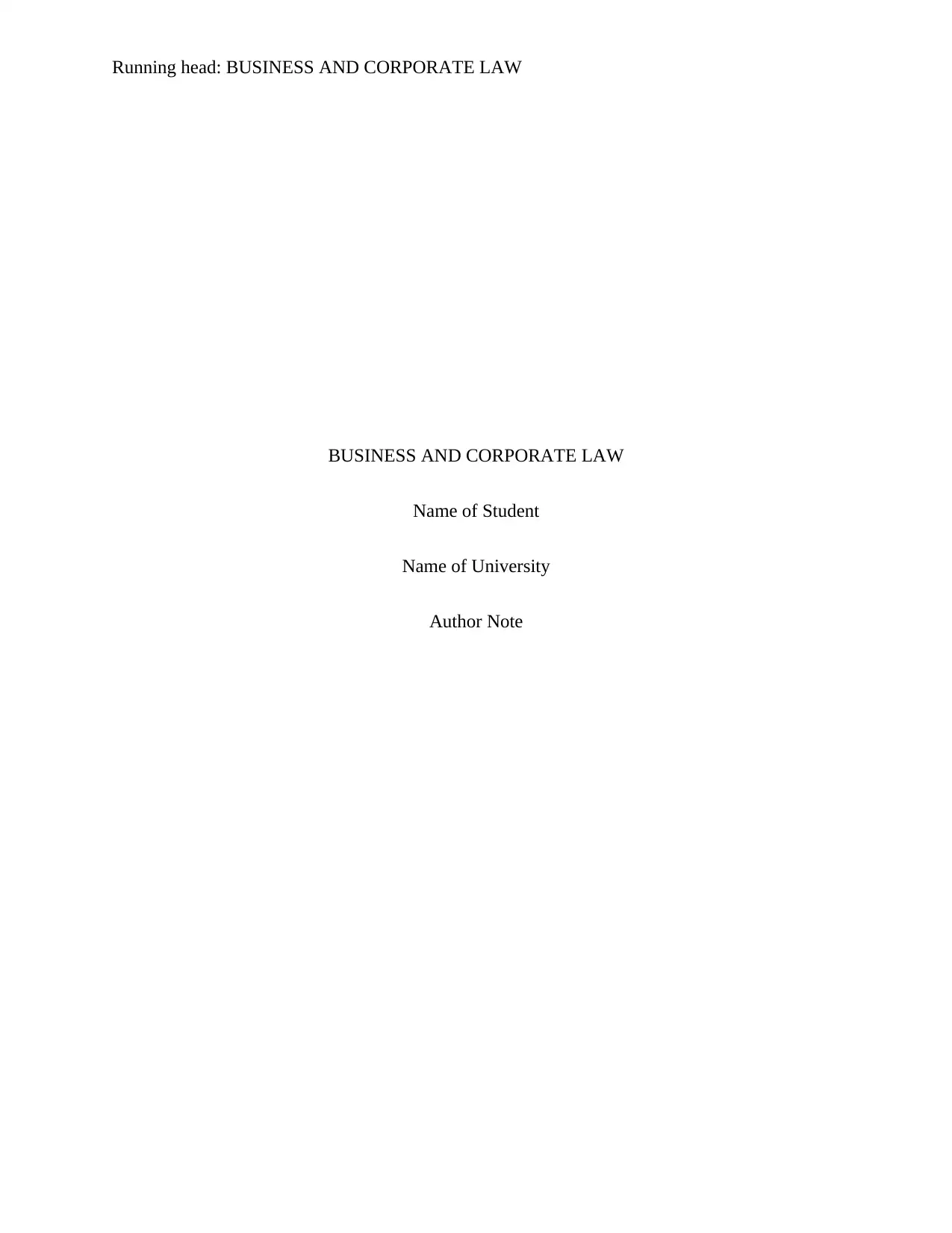
Running head: BUSINESS AND CORPORATE LAW
BUSINESS AND CORPORATE LAW
Name of Student
Name of University
Author Note
BUSINESS AND CORPORATE LAW
Name of Student
Name of University
Author Note
Paraphrase This Document
Need a fresh take? Get an instant paraphrase of this document with our AI Paraphraser
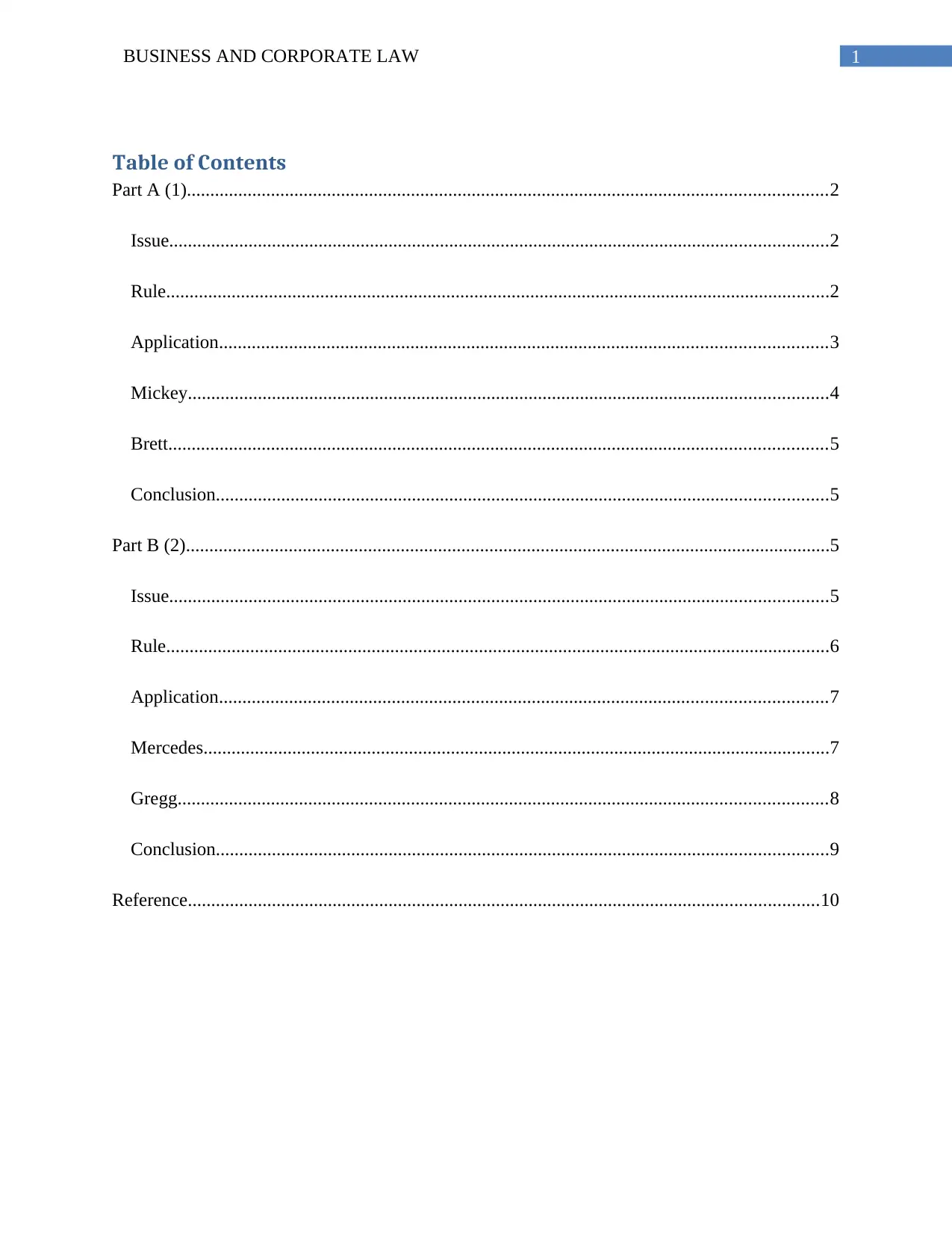
1BUSINESS AND CORPORATE LAW
Table of Contents
Part A (1).........................................................................................................................................2
Issue.............................................................................................................................................2
Rule..............................................................................................................................................2
Application..................................................................................................................................3
Mickey.........................................................................................................................................4
Brett.............................................................................................................................................5
Conclusion...................................................................................................................................5
Part B (2)..........................................................................................................................................5
Issue.............................................................................................................................................5
Rule..............................................................................................................................................6
Application..................................................................................................................................7
Mercedes......................................................................................................................................7
Gregg...........................................................................................................................................8
Conclusion...................................................................................................................................9
Reference.......................................................................................................................................10
Table of Contents
Part A (1).........................................................................................................................................2
Issue.............................................................................................................................................2
Rule..............................................................................................................................................2
Application..................................................................................................................................3
Mickey.........................................................................................................................................4
Brett.............................................................................................................................................5
Conclusion...................................................................................................................................5
Part B (2)..........................................................................................................................................5
Issue.............................................................................................................................................5
Rule..............................................................................................................................................6
Application..................................................................................................................................7
Mercedes......................................................................................................................................7
Gregg...........................................................................................................................................8
Conclusion...................................................................................................................................9
Reference.......................................................................................................................................10
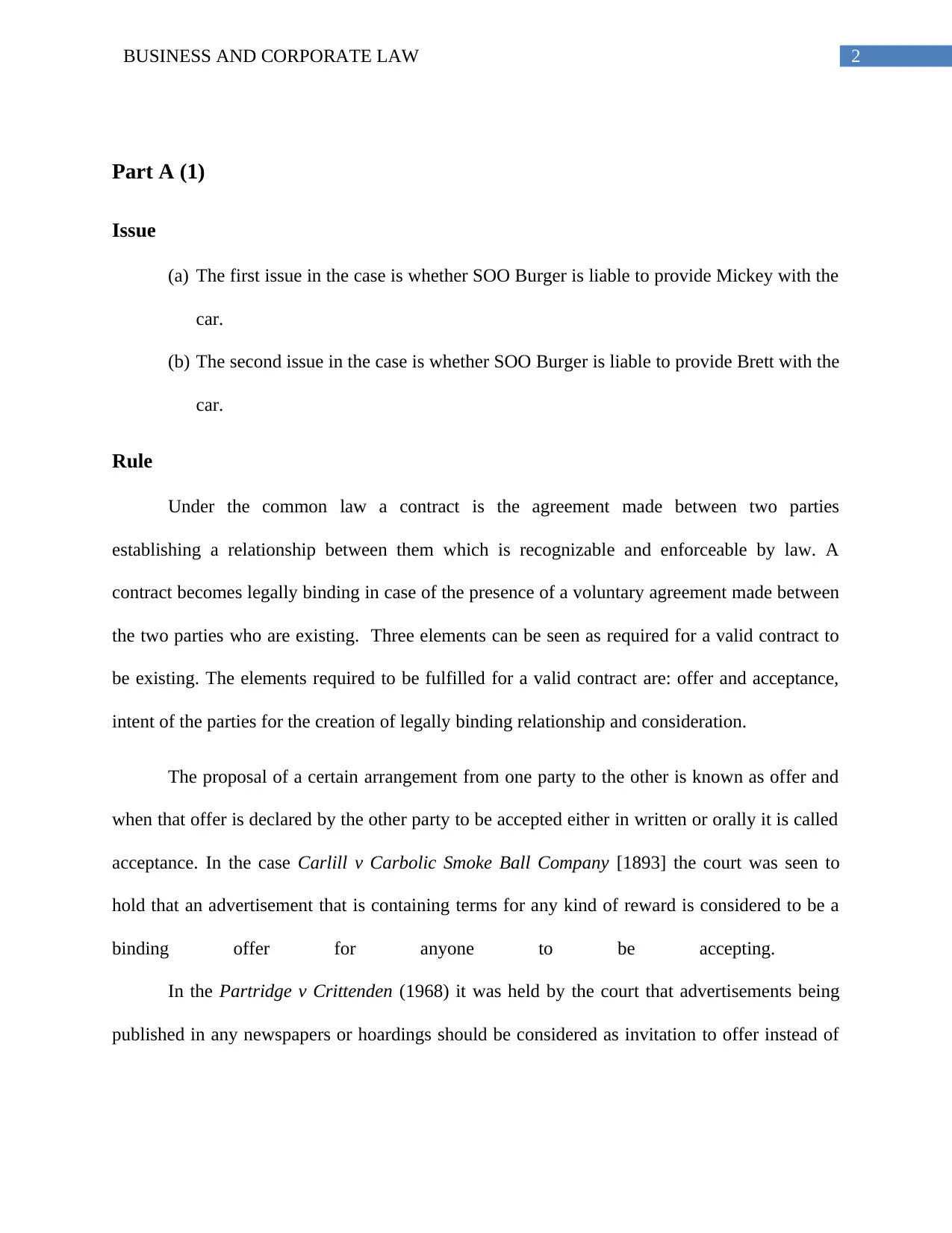
2BUSINESS AND CORPORATE LAW
Part A (1)
Issue
(a) The first issue in the case is whether SOO Burger is liable to provide Mickey with the
car.
(b) The second issue in the case is whether SOO Burger is liable to provide Brett with the
car.
Rule
Under the common law a contract is the agreement made between two parties
establishing a relationship between them which is recognizable and enforceable by law. A
contract becomes legally binding in case of the presence of a voluntary agreement made between
the two parties who are existing. Three elements can be seen as required for a valid contract to
be existing. The elements required to be fulfilled for a valid contract are: offer and acceptance,
intent of the parties for the creation of legally binding relationship and consideration.
The proposal of a certain arrangement from one party to the other is known as offer and
when that offer is declared by the other party to be accepted either in written or orally it is called
acceptance. In the case Carlill v Carbolic Smoke Ball Company [1893] the court was seen to
hold that an advertisement that is containing terms for any kind of reward is considered to be a
binding offer for anyone to be accepting.
In the Partridge v Crittenden (1968) it was held by the court that advertisements being
published in any newspapers or hoardings should be considered as invitation to offer instead of
Part A (1)
Issue
(a) The first issue in the case is whether SOO Burger is liable to provide Mickey with the
car.
(b) The second issue in the case is whether SOO Burger is liable to provide Brett with the
car.
Rule
Under the common law a contract is the agreement made between two parties
establishing a relationship between them which is recognizable and enforceable by law. A
contract becomes legally binding in case of the presence of a voluntary agreement made between
the two parties who are existing. Three elements can be seen as required for a valid contract to
be existing. The elements required to be fulfilled for a valid contract are: offer and acceptance,
intent of the parties for the creation of legally binding relationship and consideration.
The proposal of a certain arrangement from one party to the other is known as offer and
when that offer is declared by the other party to be accepted either in written or orally it is called
acceptance. In the case Carlill v Carbolic Smoke Ball Company [1893] the court was seen to
hold that an advertisement that is containing terms for any kind of reward is considered to be a
binding offer for anyone to be accepting.
In the Partridge v Crittenden (1968) it was held by the court that advertisements being
published in any newspapers or hoardings should be considered as invitation to offer instead of
⊘ This is a preview!⊘
Do you want full access?
Subscribe today to unlock all pages.

Trusted by 1+ million students worldwide
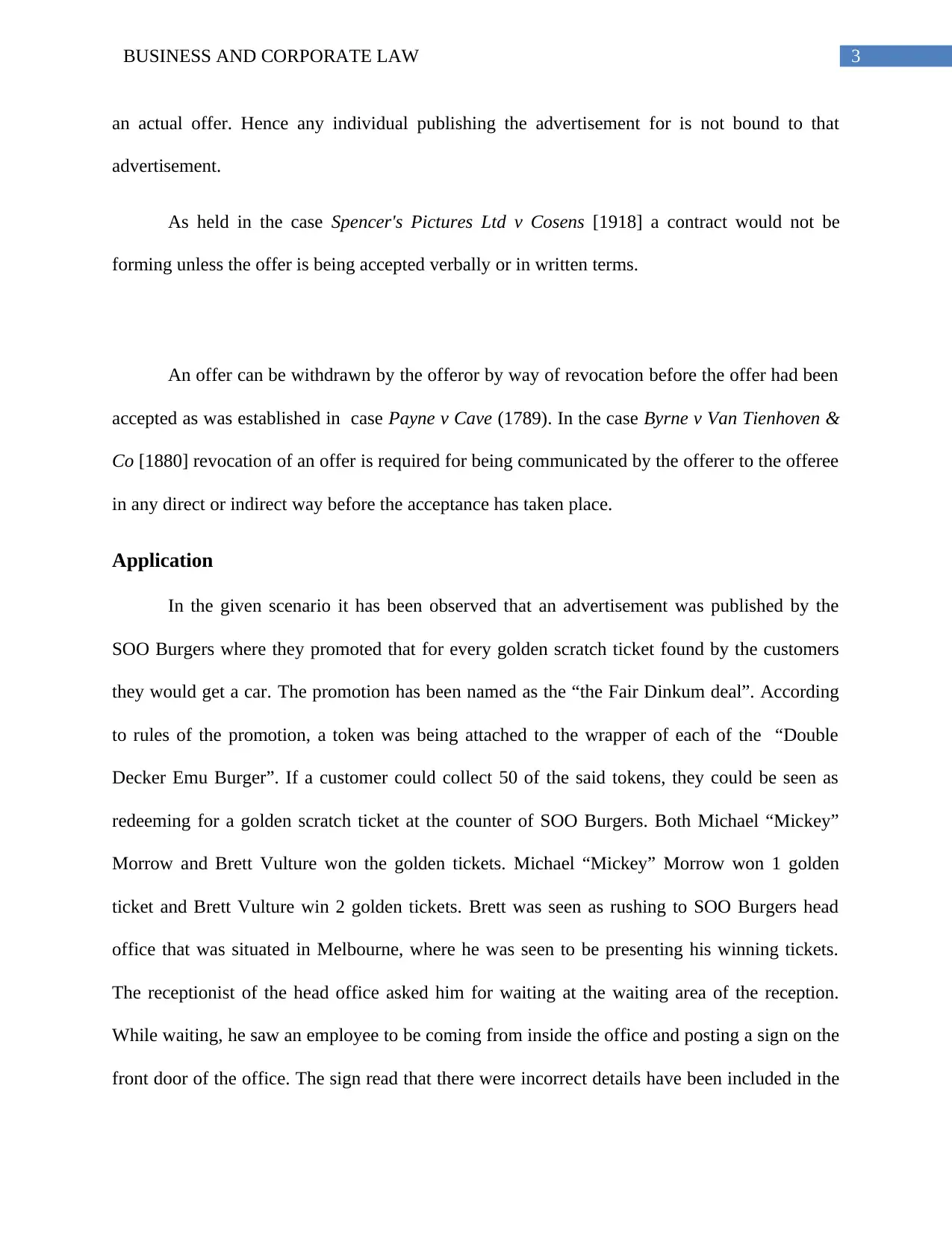
3BUSINESS AND CORPORATE LAW
an actual offer. Hence any individual publishing the advertisement for is not bound to that
advertisement.
As held in the case Spencer's Pictures Ltd v Cosens [1918] a contract would not be
forming unless the offer is being accepted verbally or in written terms.
An offer can be withdrawn by the offeror by way of revocation before the offer had been
accepted as was established in case Payne v Cave (1789). In the case Byrne v Van Tienhoven &
Co [1880] revocation of an offer is required for being communicated by the offerer to the offeree
in any direct or indirect way before the acceptance has taken place.
Application
In the given scenario it has been observed that an advertisement was published by the
SOO Burgers where they promoted that for every golden scratch ticket found by the customers
they would get a car. The promotion has been named as the “the Fair Dinkum deal”. According
to rules of the promotion, a token was being attached to the wrapper of each of the “Double
Decker Emu Burger”. If a customer could collect 50 of the said tokens, they could be seen as
redeeming for a golden scratch ticket at the counter of SOO Burgers. Both Michael “Mickey”
Morrow and Brett Vulture won the golden tickets. Michael “Mickey” Morrow won 1 golden
ticket and Brett Vulture win 2 golden tickets. Brett was seen as rushing to SOO Burgers head
office that was situated in Melbourne, where he was seen to be presenting his winning tickets.
The receptionist of the head office asked him for waiting at the waiting area of the reception.
While waiting, he saw an employee to be coming from inside the office and posting a sign on the
front door of the office. The sign read that there were incorrect details have been included in the
an actual offer. Hence any individual publishing the advertisement for is not bound to that
advertisement.
As held in the case Spencer's Pictures Ltd v Cosens [1918] a contract would not be
forming unless the offer is being accepted verbally or in written terms.
An offer can be withdrawn by the offeror by way of revocation before the offer had been
accepted as was established in case Payne v Cave (1789). In the case Byrne v Van Tienhoven &
Co [1880] revocation of an offer is required for being communicated by the offerer to the offeree
in any direct or indirect way before the acceptance has taken place.
Application
In the given scenario it has been observed that an advertisement was published by the
SOO Burgers where they promoted that for every golden scratch ticket found by the customers
they would get a car. The promotion has been named as the “the Fair Dinkum deal”. According
to rules of the promotion, a token was being attached to the wrapper of each of the “Double
Decker Emu Burger”. If a customer could collect 50 of the said tokens, they could be seen as
redeeming for a golden scratch ticket at the counter of SOO Burgers. Both Michael “Mickey”
Morrow and Brett Vulture won the golden tickets. Michael “Mickey” Morrow won 1 golden
ticket and Brett Vulture win 2 golden tickets. Brett was seen as rushing to SOO Burgers head
office that was situated in Melbourne, where he was seen to be presenting his winning tickets.
The receptionist of the head office asked him for waiting at the waiting area of the reception.
While waiting, he saw an employee to be coming from inside the office and posting a sign on the
front door of the office. The sign read that there were incorrect details have been included in the
Paraphrase This Document
Need a fresh take? Get an instant paraphrase of this document with our AI Paraphraser
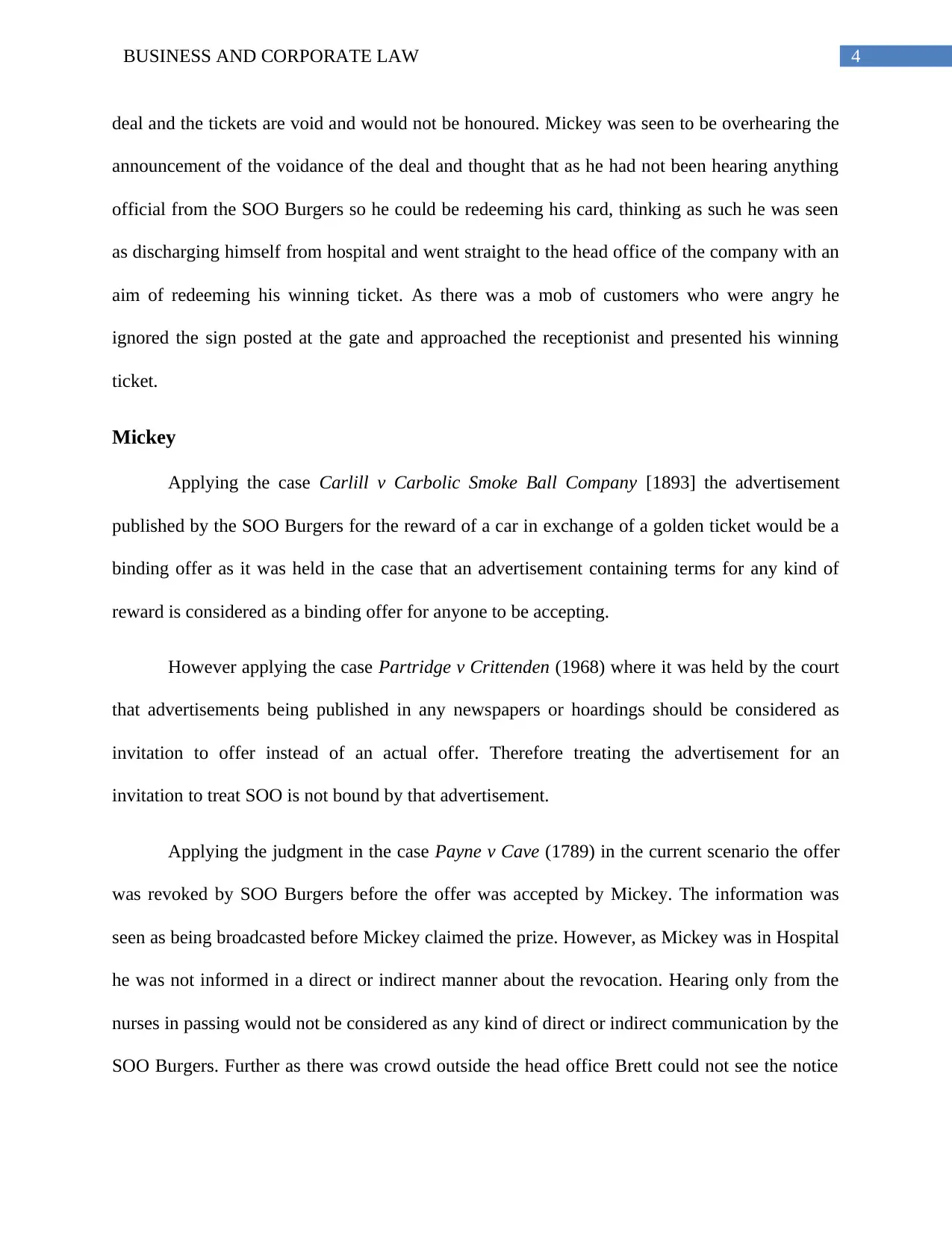
4BUSINESS AND CORPORATE LAW
deal and the tickets are void and would not be honoured. Mickey was seen to be overhearing the
announcement of the voidance of the deal and thought that as he had not been hearing anything
official from the SOO Burgers so he could be redeeming his card, thinking as such he was seen
as discharging himself from hospital and went straight to the head office of the company with an
aim of redeeming his winning ticket. As there was a mob of customers who were angry he
ignored the sign posted at the gate and approached the receptionist and presented his winning
ticket.
Mickey
Applying the case Carlill v Carbolic Smoke Ball Company [1893] the advertisement
published by the SOO Burgers for the reward of a car in exchange of a golden ticket would be a
binding offer as it was held in the case that an advertisement containing terms for any kind of
reward is considered as a binding offer for anyone to be accepting.
However applying the case Partridge v Crittenden (1968) where it was held by the court
that advertisements being published in any newspapers or hoardings should be considered as
invitation to offer instead of an actual offer. Therefore treating the advertisement for an
invitation to treat SOO is not bound by that advertisement.
Applying the judgment in the case Payne v Cave (1789) in the current scenario the offer
was revoked by SOO Burgers before the offer was accepted by Mickey. The information was
seen as being broadcasted before Mickey claimed the prize. However, as Mickey was in Hospital
he was not informed in a direct or indirect manner about the revocation. Hearing only from the
nurses in passing would not be considered as any kind of direct or indirect communication by the
SOO Burgers. Further as there was crowd outside the head office Brett could not see the notice
deal and the tickets are void and would not be honoured. Mickey was seen to be overhearing the
announcement of the voidance of the deal and thought that as he had not been hearing anything
official from the SOO Burgers so he could be redeeming his card, thinking as such he was seen
as discharging himself from hospital and went straight to the head office of the company with an
aim of redeeming his winning ticket. As there was a mob of customers who were angry he
ignored the sign posted at the gate and approached the receptionist and presented his winning
ticket.
Mickey
Applying the case Carlill v Carbolic Smoke Ball Company [1893] the advertisement
published by the SOO Burgers for the reward of a car in exchange of a golden ticket would be a
binding offer as it was held in the case that an advertisement containing terms for any kind of
reward is considered as a binding offer for anyone to be accepting.
However applying the case Partridge v Crittenden (1968) where it was held by the court
that advertisements being published in any newspapers or hoardings should be considered as
invitation to offer instead of an actual offer. Therefore treating the advertisement for an
invitation to treat SOO is not bound by that advertisement.
Applying the judgment in the case Payne v Cave (1789) in the current scenario the offer
was revoked by SOO Burgers before the offer was accepted by Mickey. The information was
seen as being broadcasted before Mickey claimed the prize. However, as Mickey was in Hospital
he was not informed in a direct or indirect manner about the revocation. Hearing only from the
nurses in passing would not be considered as any kind of direct or indirect communication by the
SOO Burgers. Further as there was crowd outside the head office Brett could not see the notice
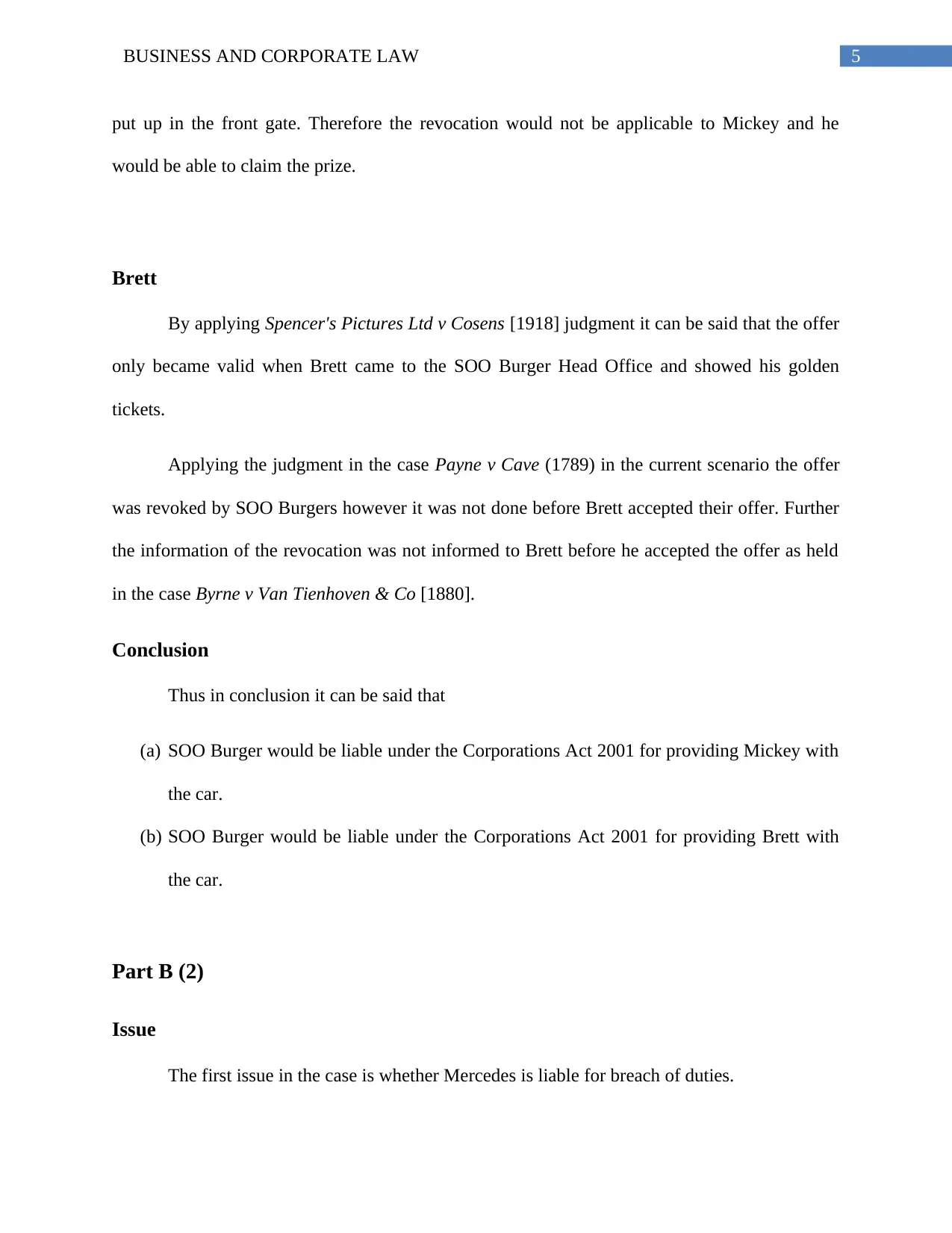
5BUSINESS AND CORPORATE LAW
put up in the front gate. Therefore the revocation would not be applicable to Mickey and he
would be able to claim the prize.
Brett
By applying Spencer's Pictures Ltd v Cosens [1918] judgment it can be said that the offer
only became valid when Brett came to the SOO Burger Head Office and showed his golden
tickets.
Applying the judgment in the case Payne v Cave (1789) in the current scenario the offer
was revoked by SOO Burgers however it was not done before Brett accepted their offer. Further
the information of the revocation was not informed to Brett before he accepted the offer as held
in the case Byrne v Van Tienhoven & Co [1880].
Conclusion
Thus in conclusion it can be said that
(a) SOO Burger would be liable under the Corporations Act 2001 for providing Mickey with
the car.
(b) SOO Burger would be liable under the Corporations Act 2001 for providing Brett with
the car.
Part B (2)
Issue
The first issue in the case is whether Mercedes is liable for breach of duties.
put up in the front gate. Therefore the revocation would not be applicable to Mickey and he
would be able to claim the prize.
Brett
By applying Spencer's Pictures Ltd v Cosens [1918] judgment it can be said that the offer
only became valid when Brett came to the SOO Burger Head Office and showed his golden
tickets.
Applying the judgment in the case Payne v Cave (1789) in the current scenario the offer
was revoked by SOO Burgers however it was not done before Brett accepted their offer. Further
the information of the revocation was not informed to Brett before he accepted the offer as held
in the case Byrne v Van Tienhoven & Co [1880].
Conclusion
Thus in conclusion it can be said that
(a) SOO Burger would be liable under the Corporations Act 2001 for providing Mickey with
the car.
(b) SOO Burger would be liable under the Corporations Act 2001 for providing Brett with
the car.
Part B (2)
Issue
The first issue in the case is whether Mercedes is liable for breach of duties.
⊘ This is a preview!⊘
Do you want full access?
Subscribe today to unlock all pages.

Trusted by 1+ million students worldwide
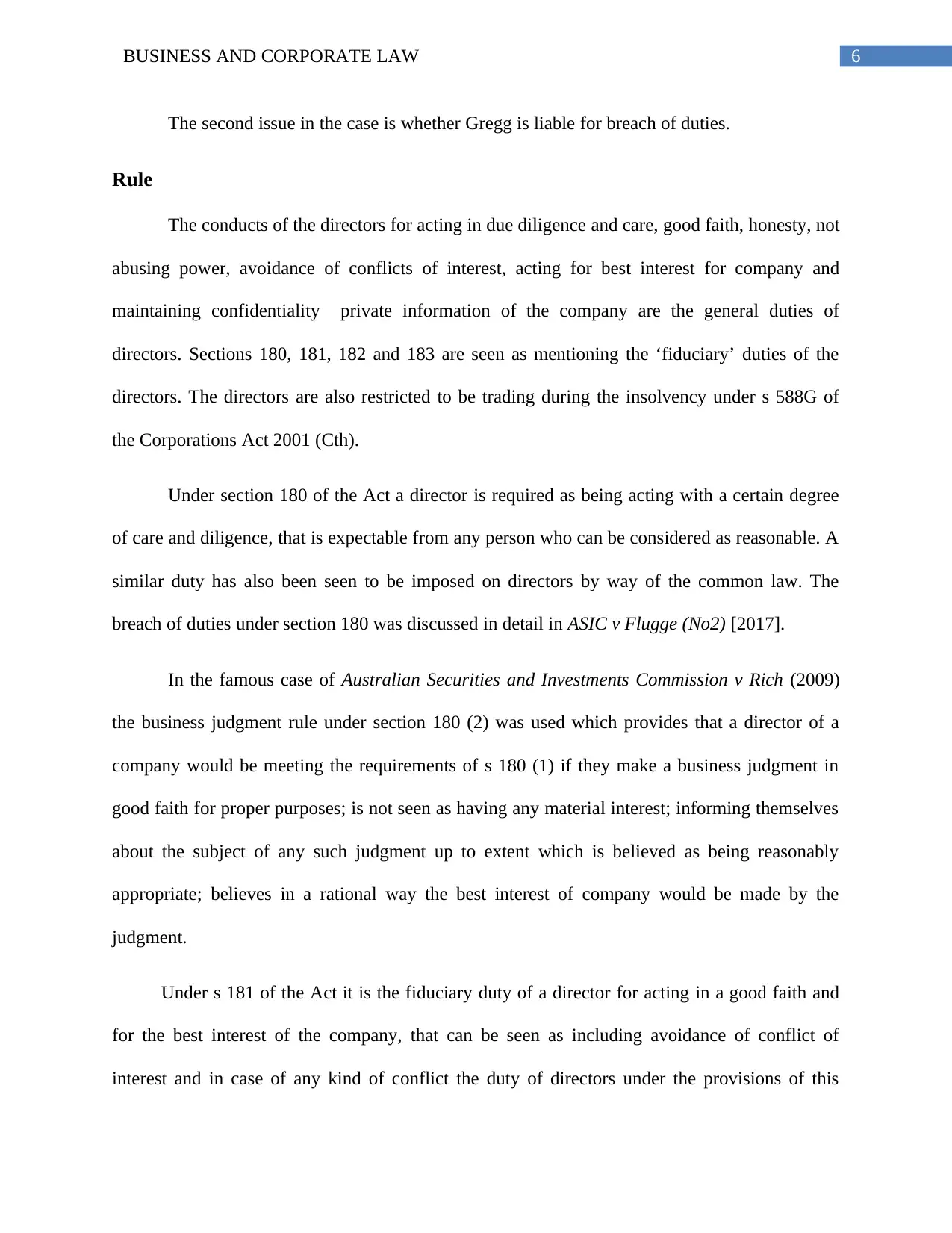
6BUSINESS AND CORPORATE LAW
The second issue in the case is whether Gregg is liable for breach of duties.
Rule
The conducts of the directors for acting in due diligence and care, good faith, honesty, not
abusing power, avoidance of conflicts of interest, acting for best interest for company and
maintaining confidentiality private information of the company are the general duties of
directors. Sections 180, 181, 182 and 183 are seen as mentioning the ‘fiduciary’ duties of the
directors. The directors are also restricted to be trading during the insolvency under s 588G of
the Corporations Act 2001 (Cth).
Under section 180 of the Act a director is required as being acting with a certain degree
of care and diligence, that is expectable from any person who can be considered as reasonable. A
similar duty has also been seen to be imposed on directors by way of the common law. The
breach of duties under section 180 was discussed in detail in ASIC v Flugge (No2) [2017].
In the famous case of Australian Securities and Investments Commission v Rich (2009)
the business judgment rule under section 180 (2) was used which provides that a director of a
company would be meeting the requirements of s 180 (1) if they make a business judgment in
good faith for proper purposes; is not seen as having any material interest; informing themselves
about the subject of any such judgment up to extent which is believed as being reasonably
appropriate; believes in a rational way the best interest of company would be made by the
judgment.
Under s 181 of the Act it is the fiduciary duty of a director for acting in a good faith and
for the best interest of the company, that can be seen as including avoidance of conflict of
interest and in case of any kind of conflict the duty of directors under the provisions of this
The second issue in the case is whether Gregg is liable for breach of duties.
Rule
The conducts of the directors for acting in due diligence and care, good faith, honesty, not
abusing power, avoidance of conflicts of interest, acting for best interest for company and
maintaining confidentiality private information of the company are the general duties of
directors. Sections 180, 181, 182 and 183 are seen as mentioning the ‘fiduciary’ duties of the
directors. The directors are also restricted to be trading during the insolvency under s 588G of
the Corporations Act 2001 (Cth).
Under section 180 of the Act a director is required as being acting with a certain degree
of care and diligence, that is expectable from any person who can be considered as reasonable. A
similar duty has also been seen to be imposed on directors by way of the common law. The
breach of duties under section 180 was discussed in detail in ASIC v Flugge (No2) [2017].
In the famous case of Australian Securities and Investments Commission v Rich (2009)
the business judgment rule under section 180 (2) was used which provides that a director of a
company would be meeting the requirements of s 180 (1) if they make a business judgment in
good faith for proper purposes; is not seen as having any material interest; informing themselves
about the subject of any such judgment up to extent which is believed as being reasonably
appropriate; believes in a rational way the best interest of company would be made by the
judgment.
Under s 181 of the Act it is the fiduciary duty of a director for acting in a good faith and
for the best interest of the company, that can be seen as including avoidance of conflict of
interest and in case of any kind of conflict the duty of directors under the provisions of this
Paraphrase This Document
Need a fresh take? Get an instant paraphrase of this document with our AI Paraphraser
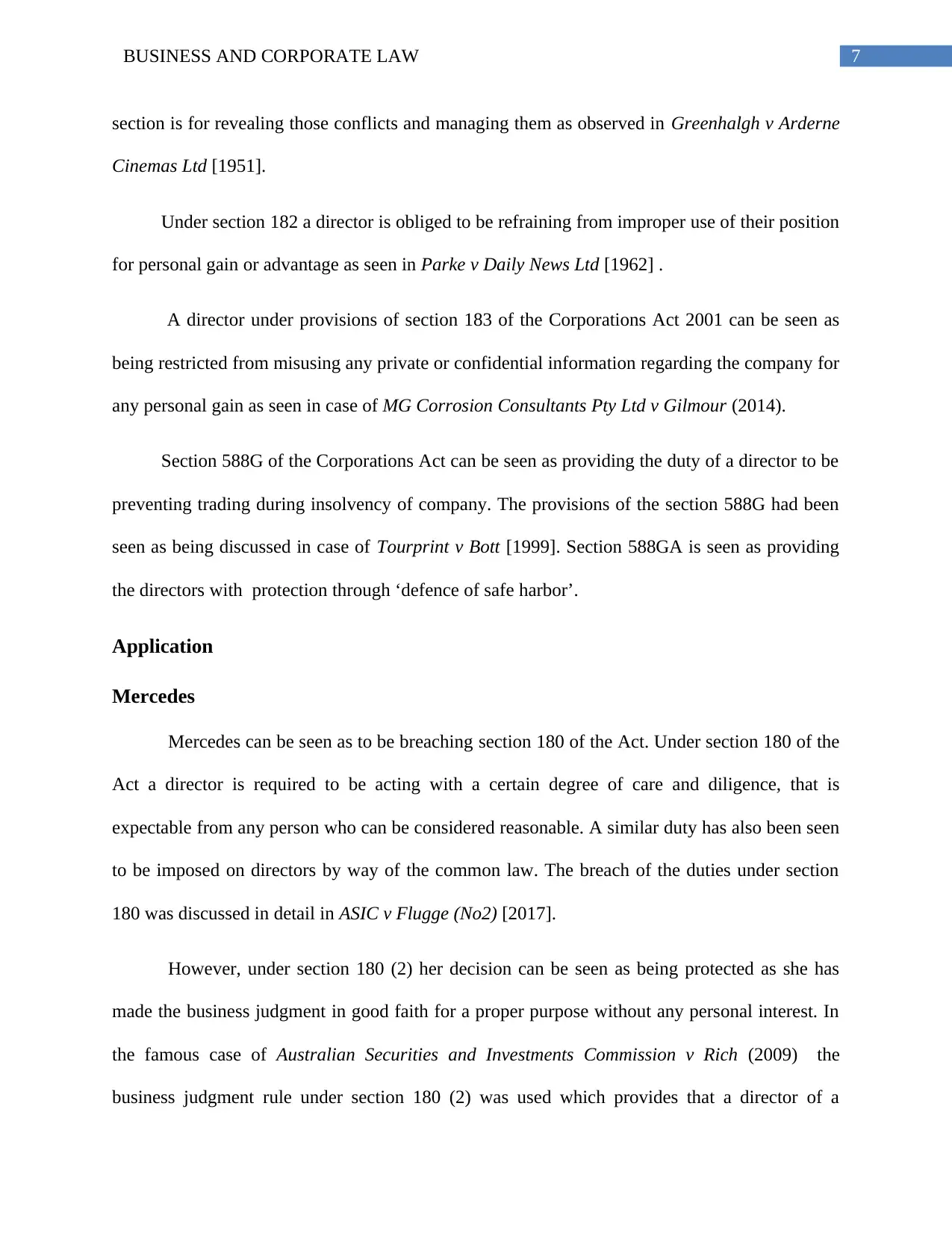
7BUSINESS AND CORPORATE LAW
section is for revealing those conflicts and managing them as observed in Greenhalgh v Arderne
Cinemas Ltd [1951].
Under section 182 a director is obliged to be refraining from improper use of their position
for personal gain or advantage as seen in Parke v Daily News Ltd [1962] .
A director under provisions of section 183 of the Corporations Act 2001 can be seen as
being restricted from misusing any private or confidential information regarding the company for
any personal gain as seen in case of MG Corrosion Consultants Pty Ltd v Gilmour (2014).
Section 588G of the Corporations Act can be seen as providing the duty of a director to be
preventing trading during insolvency of company. The provisions of the section 588G had been
seen as being discussed in case of Tourprint v Bott [1999]. Section 588GA is seen as providing
the directors with protection through ‘defence of safe harbor’.
Application
Mercedes
Mercedes can be seen as to be breaching section 180 of the Act. Under section 180 of the
Act a director is required to be acting with a certain degree of care and diligence, that is
expectable from any person who can be considered reasonable. A similar duty has also been seen
to be imposed on directors by way of the common law. The breach of the duties under section
180 was discussed in detail in ASIC v Flugge (No2) [2017].
However, under section 180 (2) her decision can be seen as being protected as she has
made the business judgment in good faith for a proper purpose without any personal interest. In
the famous case of Australian Securities and Investments Commission v Rich (2009) the
business judgment rule under section 180 (2) was used which provides that a director of a
section is for revealing those conflicts and managing them as observed in Greenhalgh v Arderne
Cinemas Ltd [1951].
Under section 182 a director is obliged to be refraining from improper use of their position
for personal gain or advantage as seen in Parke v Daily News Ltd [1962] .
A director under provisions of section 183 of the Corporations Act 2001 can be seen as
being restricted from misusing any private or confidential information regarding the company for
any personal gain as seen in case of MG Corrosion Consultants Pty Ltd v Gilmour (2014).
Section 588G of the Corporations Act can be seen as providing the duty of a director to be
preventing trading during insolvency of company. The provisions of the section 588G had been
seen as being discussed in case of Tourprint v Bott [1999]. Section 588GA is seen as providing
the directors with protection through ‘defence of safe harbor’.
Application
Mercedes
Mercedes can be seen as to be breaching section 180 of the Act. Under section 180 of the
Act a director is required to be acting with a certain degree of care and diligence, that is
expectable from any person who can be considered reasonable. A similar duty has also been seen
to be imposed on directors by way of the common law. The breach of the duties under section
180 was discussed in detail in ASIC v Flugge (No2) [2017].
However, under section 180 (2) her decision can be seen as being protected as she has
made the business judgment in good faith for a proper purpose without any personal interest. In
the famous case of Australian Securities and Investments Commission v Rich (2009) the
business judgment rule under section 180 (2) was used which provides that a director of a
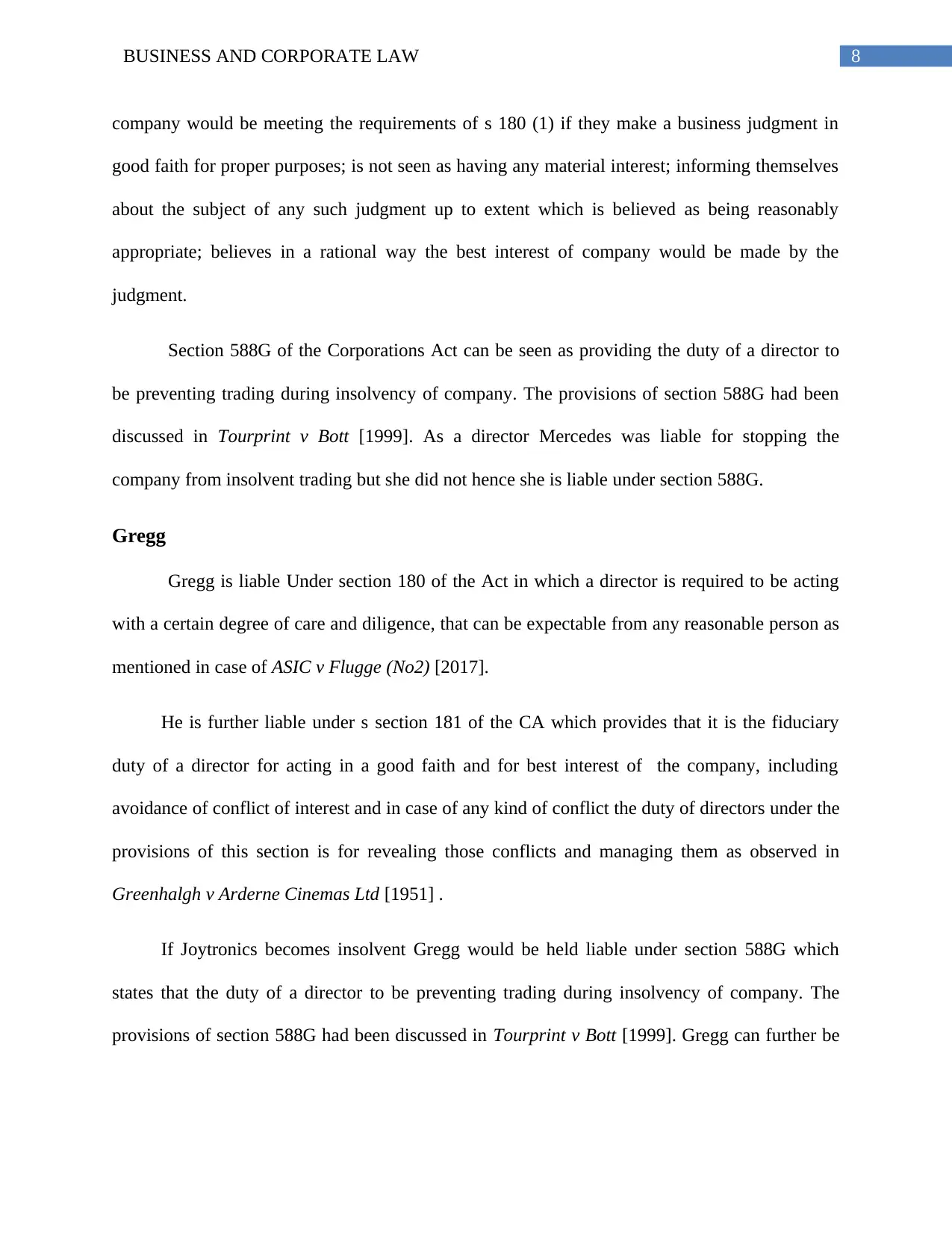
8BUSINESS AND CORPORATE LAW
company would be meeting the requirements of s 180 (1) if they make a business judgment in
good faith for proper purposes; is not seen as having any material interest; informing themselves
about the subject of any such judgment up to extent which is believed as being reasonably
appropriate; believes in a rational way the best interest of company would be made by the
judgment.
Section 588G of the Corporations Act can be seen as providing the duty of a director to
be preventing trading during insolvency of company. The provisions of section 588G had been
discussed in Tourprint v Bott [1999]. As a director Mercedes was liable for stopping the
company from insolvent trading but she did not hence she is liable under section 588G.
Gregg
Gregg is liable Under section 180 of the Act in which a director is required to be acting
with a certain degree of care and diligence, that can be expectable from any reasonable person as
mentioned in case of ASIC v Flugge (No2) [2017].
He is further liable under s section 181 of the CA which provides that it is the fiduciary
duty of a director for acting in a good faith and for best interest of the company, including
avoidance of conflict of interest and in case of any kind of conflict the duty of directors under the
provisions of this section is for revealing those conflicts and managing them as observed in
Greenhalgh v Arderne Cinemas Ltd [1951] .
If Joytronics becomes insolvent Gregg would be held liable under section 588G which
states that the duty of a director to be preventing trading during insolvency of company. The
provisions of section 588G had been discussed in Tourprint v Bott [1999]. Gregg can further be
company would be meeting the requirements of s 180 (1) if they make a business judgment in
good faith for proper purposes; is not seen as having any material interest; informing themselves
about the subject of any such judgment up to extent which is believed as being reasonably
appropriate; believes in a rational way the best interest of company would be made by the
judgment.
Section 588G of the Corporations Act can be seen as providing the duty of a director to
be preventing trading during insolvency of company. The provisions of section 588G had been
discussed in Tourprint v Bott [1999]. As a director Mercedes was liable for stopping the
company from insolvent trading but she did not hence she is liable under section 588G.
Gregg
Gregg is liable Under section 180 of the Act in which a director is required to be acting
with a certain degree of care and diligence, that can be expectable from any reasonable person as
mentioned in case of ASIC v Flugge (No2) [2017].
He is further liable under s section 181 of the CA which provides that it is the fiduciary
duty of a director for acting in a good faith and for best interest of the company, including
avoidance of conflict of interest and in case of any kind of conflict the duty of directors under the
provisions of this section is for revealing those conflicts and managing them as observed in
Greenhalgh v Arderne Cinemas Ltd [1951] .
If Joytronics becomes insolvent Gregg would be held liable under section 588G which
states that the duty of a director to be preventing trading during insolvency of company. The
provisions of section 588G had been discussed in Tourprint v Bott [1999]. Gregg can further be
⊘ This is a preview!⊘
Do you want full access?
Subscribe today to unlock all pages.

Trusted by 1+ million students worldwide
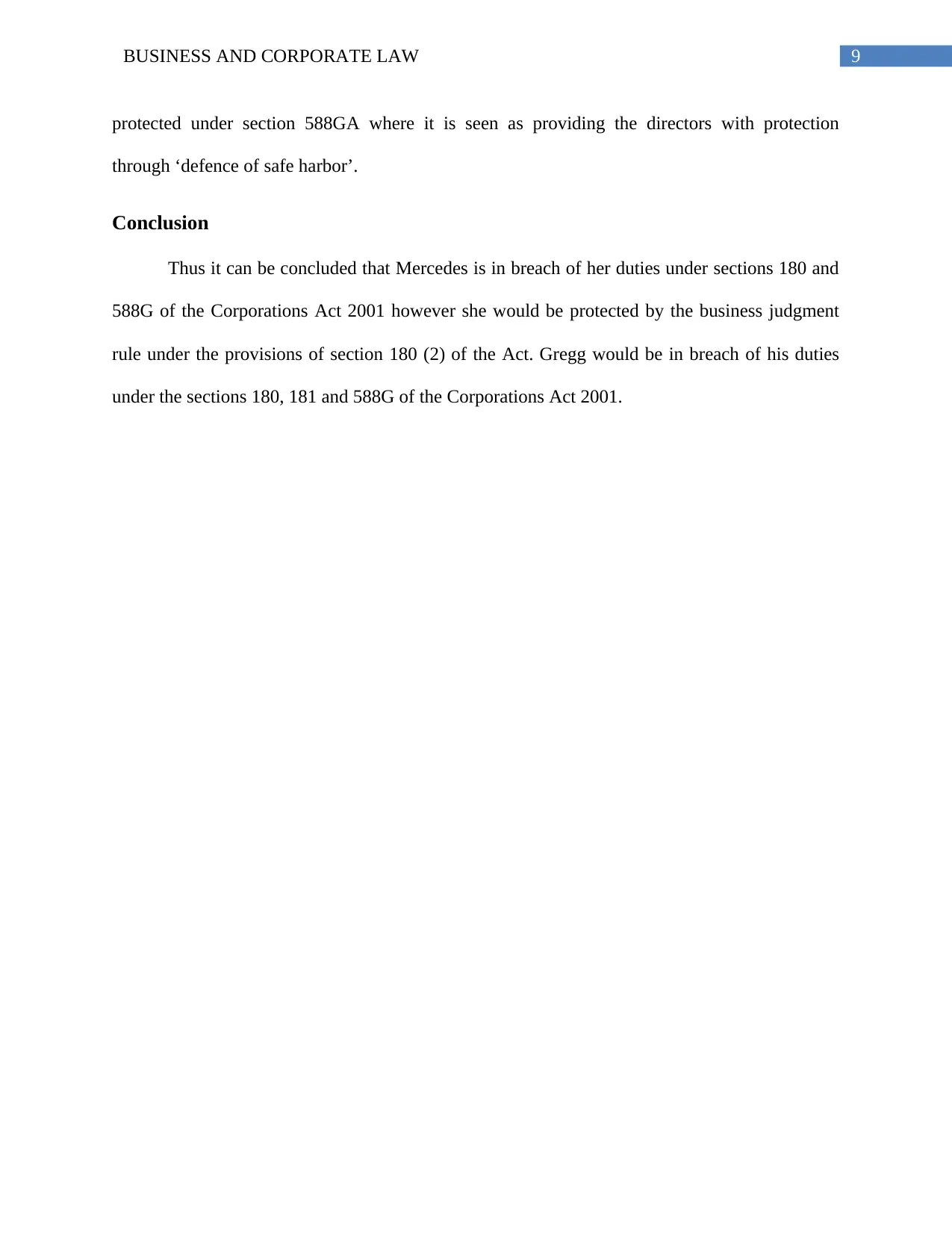
9BUSINESS AND CORPORATE LAW
protected under section 588GA where it is seen as providing the directors with protection
through ‘defence of safe harbor’.
Conclusion
Thus it can be concluded that Mercedes is in breach of her duties under sections 180 and
588G of the Corporations Act 2001 however she would be protected by the business judgment
rule under the provisions of section 180 (2) of the Act. Gregg would be in breach of his duties
under the sections 180, 181 and 588G of the Corporations Act 2001.
protected under section 588GA where it is seen as providing the directors with protection
through ‘defence of safe harbor’.
Conclusion
Thus it can be concluded that Mercedes is in breach of her duties under sections 180 and
588G of the Corporations Act 2001 however she would be protected by the business judgment
rule under the provisions of section 180 (2) of the Act. Gregg would be in breach of his duties
under the sections 180, 181 and 588G of the Corporations Act 2001.
Paraphrase This Document
Need a fresh take? Get an instant paraphrase of this document with our AI Paraphraser
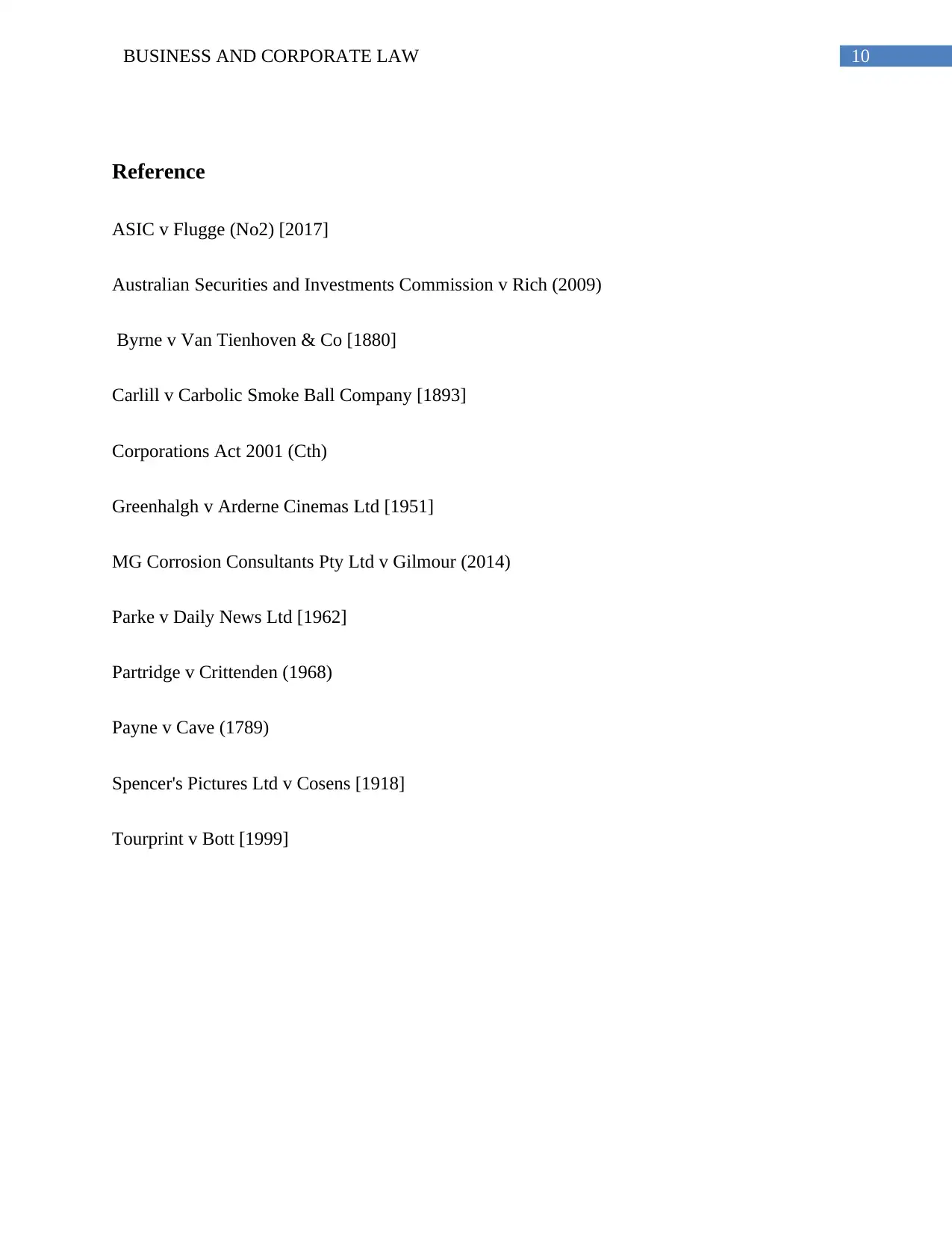
10BUSINESS AND CORPORATE LAW
Reference
ASIC v Flugge (No2) [2017]
Australian Securities and Investments Commission v Rich (2009)
Byrne v Van Tienhoven & Co [1880]
Carlill v Carbolic Smoke Ball Company [1893]
Corporations Act 2001 (Cth)
Greenhalgh v Arderne Cinemas Ltd [1951]
MG Corrosion Consultants Pty Ltd v Gilmour (2014)
Parke v Daily News Ltd [1962]
Partridge v Crittenden (1968)
Payne v Cave (1789)
Spencer's Pictures Ltd v Cosens [1918]
Tourprint v Bott [1999]
Reference
ASIC v Flugge (No2) [2017]
Australian Securities and Investments Commission v Rich (2009)
Byrne v Van Tienhoven & Co [1880]
Carlill v Carbolic Smoke Ball Company [1893]
Corporations Act 2001 (Cth)
Greenhalgh v Arderne Cinemas Ltd [1951]
MG Corrosion Consultants Pty Ltd v Gilmour (2014)
Parke v Daily News Ltd [1962]
Partridge v Crittenden (1968)
Payne v Cave (1789)
Spencer's Pictures Ltd v Cosens [1918]
Tourprint v Bott [1999]
1 out of 11
Related Documents
Your All-in-One AI-Powered Toolkit for Academic Success.
+13062052269
info@desklib.com
Available 24*7 on WhatsApp / Email
![[object Object]](/_next/static/media/star-bottom.7253800d.svg)
Unlock your academic potential
Copyright © 2020–2025 A2Z Services. All Rights Reserved. Developed and managed by ZUCOL.





